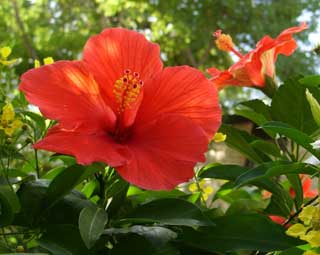Hibiscus Rosa-sinensis
Common Names: Chinese hibiscus, rose-of-China, Hawaiian hibiscus
Family: Malvaceae (mallow Family)
Description
Chinese hibiscus is a large shrub or small tree that gets up to 15 ft (4.5 m) tall in frost free climates. The toothed leaves are arranged alternately and are quite variable, but tend to be large, dark green, and shiny. Chinese hibiscus has a coarse texture and normally grows upright and broad spreading. It usually grows as a bush with many stems. Flowers are glorious and huge at their best -- up to 6 in (15 cm) in diameter -- and occur in many colors. Most are flared and have a bell shape; they may be single or double, smooth or scalloped. The flowers have a long central tube with stamens and pistils at the tip. Hundreds of selections are available, with flower colors from scarlet to orange to yellow to white.
Location
The experts aren't sure, but Hibiscus rosa-sinensis is thought to have originated in tropicalAsia .
Culture
Deep, moderately fertile, well drained, and slightly acidic soil is ideal for Chinese hibiscus. Regular pruning is necessary in most cases to shape and control the size of the bush, and to remove unwanted stems.
Light: Hibiscus likes full sun or partial shade from very high trees.
Moisture: A fairly moist soil is best.
Propagation: Propagate the cultivars of Chinese hibiscus from fast growing tip cuttings.
Usage
Use Chinese hibiscus as a foundation plant around houses and buildings in frost free areas. It makes a spectacular specimen shrub. Put a pair on either side of the driveway. The Chinese hibiscus is underused as a standard or tree form. For a spectacular flowering tree, removes the lower branches and allow to grow as it will! In colder areas, the hibiscus makes a wonderful summer plant that can be grown as an annual or containerized and greenhoused in wintertime.
Features
Chinese hibiscus produces large, extremely showy flowers almost all year! This writer's grandfather specialized in grafting various colors of hibiscus onto the same shrub. Traffic would stop to check out the red, white and blue flowers all on the same bush in the front yard. Anyone interested in attracting hummingbirds should have a hibiscus. Many types of butterflies are attracted as well, including Cloudless Sulfurs, blues, and Gulf Fritillaries.
Family: Malvaceae (mallow Family)
Description
Chinese hibiscus is a large shrub or small tree that gets up to 15 ft (4.5 m) tall in frost free climates. The toothed leaves are arranged alternately and are quite variable, but tend to be large, dark green, and shiny. Chinese hibiscus has a coarse texture and normally grows upright and broad spreading. It usually grows as a bush with many stems. Flowers are glorious and huge at their best -- up to 6 in (15 cm) in diameter -- and occur in many colors. Most are flared and have a bell shape; they may be single or double, smooth or scalloped. The flowers have a long central tube with stamens and pistils at the tip. Hundreds of selections are available, with flower colors from scarlet to orange to yellow to white.
Location
The experts aren't sure, but Hibiscus rosa-sinensis is thought to have originated in tropical
Culture
Deep, moderately fertile, well drained, and slightly acidic soil is ideal for Chinese hibiscus. Regular pruning is necessary in most cases to shape and control the size of the bush, and to remove unwanted stems.
Light: Hibiscus likes full sun or partial shade from very high trees.
Moisture: A fairly moist soil is best.
Propagation: Propagate the cultivars of Chinese hibiscus from fast growing tip cuttings.
Usage
Use Chinese hibiscus as a foundation plant around houses and buildings in frost free areas. It makes a spectacular specimen shrub. Put a pair on either side of the driveway. The Chinese hibiscus is underused as a standard or tree form. For a spectacular flowering tree, removes the lower branches and allow to grow as it will! In colder areas, the hibiscus makes a wonderful summer plant that can be grown as an annual or containerized and greenhoused in wintertime.
Features
Chinese hibiscus produces large, extremely showy flowers almost all year! This writer's grandfather specialized in grafting various colors of hibiscus onto the same shrub. Traffic would stop to check out the red, white and blue flowers all on the same bush in the front yard. Anyone interested in attracting hummingbirds should have a hibiscus. Many types of butterflies are attracted as well, including Cloudless Sulfurs, blues, and Gulf Fritillaries.



























Comments
Post a Comment